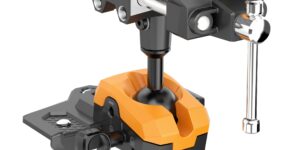Nikon Metrology And Magestic Systems Collaborate On Composite Part Process
Nikon Metrology (Leuven, Belgium) and Magestic Systems, Inc. (MSI; Westwood, NJ)) jointly introduced an innovative fabrication solution for increasing production of right-first-time composite parts that harnesses the vast capabilities of both Laser Radar technology and the Ply Compensation? System (PCS?)….
Posted: March 8, 2010
Nikon Metrology (Leuven, Belgium) and Magestic Systems, Inc. (MSI; Westwood, NJ)) jointly introduced an innovative fabrication solution for increasing production of right-first-time composite parts that harnesses the vast capabilities of both Laser Radar technology and the Ply Compensation? System (PCS?).
The benefits of this methodology are twofold: first, manufacturers can overcome the difficult engineering specifications set in place for composite parts; and second, they can achieve success with minimal waste.
The synergy between PCS? and Laser Radar offers composite part manufacturers a seamless solution ? utilizing metrology, ply nesting and laser projection technologies to produce composite parts within engineering tolerances. By combining Laser Radar and PCS? technologies, manufacturers put in place an automated metrology assisted production process that delivers parts of predictable quality, while rigorously reducing scrap and maintaining accuracy, scalability and ease of use.
Despite their generally high cost, composite materials have gained popularity in high-performance products that need to be lightweight, and at the same time strong enough to take harsh loading conditions. Today, composite materials are widely used in aviation components (tails, wings, fuselages, propellers), space vehicles, boat hulls, racecar bodies, storage tanks, turbine blades and even baseball bats.
LASER RADAR DRIVES PCSTM BY CAPTURING THE SURFACE GEOMETRY OF COMPOSITE PARTS
? Fully automatic measurement without requiring SMR or other targets
? All required geometry information captured in one go
? Ergonomic operation ? no mechanical constraints
COMPOSITE PART MANUFACTURERS FACE PRODUCTION ISSUES
Traditional production methods, which have become standards for steel and aluminum industrial production, will not suffice for serial production of composite parts. A variety of factors often prevent manufacturers from keeping geometric deviation within specification, whether it is the nature of combined composites? substrate, resin, and reinforcement materials or even the method by which the parts are molded. Low process repeatability generates lengthy manual rework and an intolerable number of fail components that end up on the scrap pile.
PCSTM: A UNIQUE ALTERNATIVE TO THE CURRENT MACHINING PROCESS
?As a full-scale enterprise solution, our Ply Compensation? System provides a unique alternative to the current machining process for composite part fabrication,? says Mike Weber, Magestic vice president of operations and business development. ?PCSTM takes parts that have been produced slightly outside of engineering tolerances, and builds them up by single or multiple composite compensation ply layers requirements ? the first time through the production process. This revolutionary method ensures that as-built composite parts adhere to as-designed specifications, while reducing material usage and improving efficiency.?
LASER RADAR CAPTURES COMPOSITES? NOMINAL GEOMETRY DEVIATION
The process starts with identifying those surface areas on composite parts that need compensation ply treatment. ?Within a range of 60 m, our contactless Laser Radar system captures the surface geometry of composite parts of any shape and size, without requiring SMR or other targets?, explains Francky Demeester, Nikon Metrology vice president of business development for large-scale metrology.
?The Laser Radar is fully automatable and programmable, and measures nominal deviation very accurately, both in plane and surface vector intersection modes (PVI and SVI). PVI measurements have shown an order of magnitude improvement in measurement accuracy over other single-point measurement systems, in particular on composite materials. The integration of Laser Radar into innovative manufacturing methods illustrates the impact of Metrology Assisted Production on composite part production quality and throughput.?
AUTOMATIC PROCESS TO MEASURE, NEST, CUT, AND LAY UP COMPENSATION PLIES
Based on the Laser Radar geometry data and the resulting nominal deviation of the tool surface, the Ply Compensation? System manages the definition and creation of multi-layer compensation plies. After processing this critical step, TruNEST? builds nests of the necessary compensation plies and automatically cuts them out to be laid up. TruLASER? View kits the compensation plies while still on the cutting table and projects the exact location of where on the deficient part they need to be placed, keeping all grain constraints in mind.
Following this, the part is ready to be re-cured to obtain final geometry. The finished composite part is then measured again with Laser Radar for geometry deviation. By producing composite parts correctly the first time, immediate savings can be noted in the minimization of waste and the maximization of accuracy, part quality, and process efficiency.
HEAD START IN SERIAL PRODUCTION OF COMPOSITE PARTS
?Our focus with the development of this application was to provide a solution that integrated the unique capabilities of both manufacturers to best-fit industry needs,? concludes Weber. ?With the current state of the world economy and the rising costs of composite materials, we put a premium on cost efficiency to complement the unique capabilities of this breakthrough solution. All its economic and quality benefits ensure a positive bottom line return on investment for world-class manufacturers around the globe.?
————————————————————————
Nikon Metrology, Magestic Systems, Inc.









